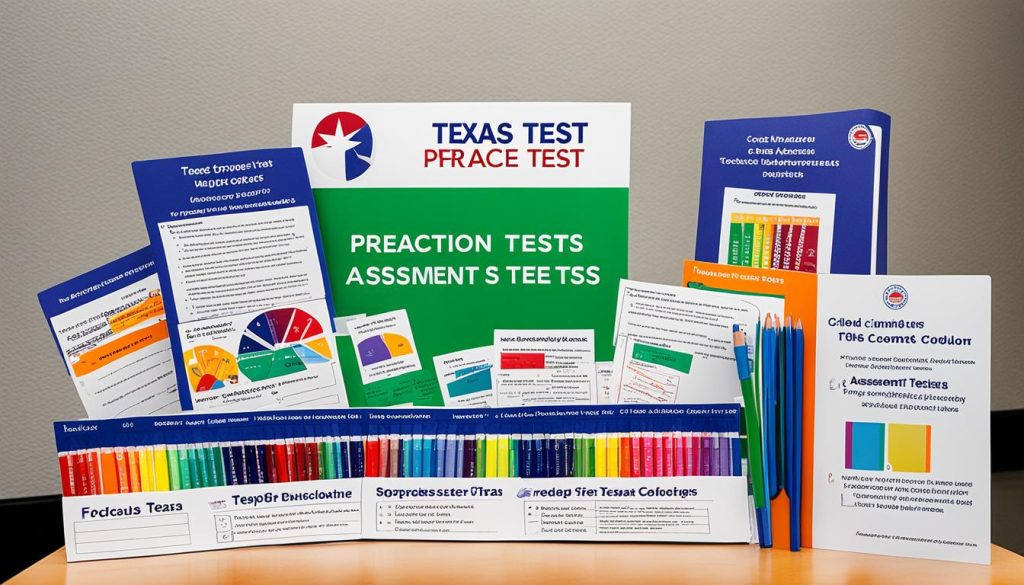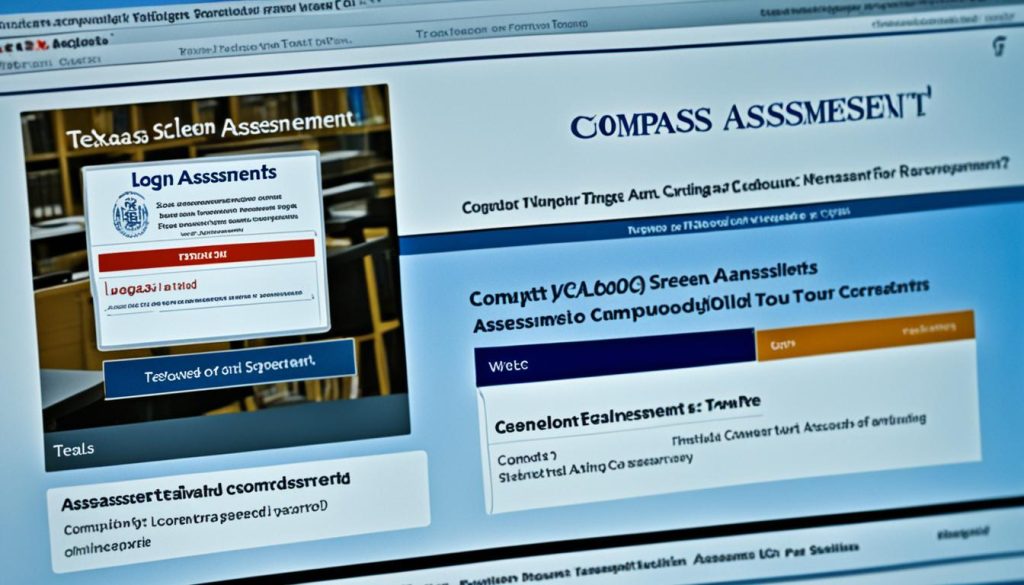TELPAS Practice Test Resources for Texas Educators
Welcome to our comprehensive TELPAS Practice Test resources and preparation materials specifically designed for Texas educators. Whether you are looking for online assessments, test preparation strategies, or practice questions, we have the tools to help you excel in the TELPAS assessment.

As an educator in Texas, you understand the importance of the TELPAS assessment in measuring English language proficiency. Our resources are tailored to help you navigate this assessment and ensure your students are prepared for success.
Preparing for the TELPAS assessment can be daunting, but with our practice tests, activities, and strategies, you can confidently guide your students towards proficiency. Let’s dive into the details and discover how our resources can support your teaching and enhance your students’ language skills.
Key Takeaways:
- TELPAS Practice Test resources specifically designed for Texas educators
- Online assessments, test preparation strategies, and practice questions available
- Enhance your teaching with TELPAS-specific practice activities and exercises
- Effective strategies to optimize test preparation
- Empower your students to excel in English language proficiency
Understanding the TELPAS Assessment
In this section, we will provide a comprehensive overview of the TELPAS assessment, exploring its purpose, structure, and expectations. TELPAS, which stands for the Texas English Language Proficiency Assessment System, is designed to measure the English language proficiency of English learners (ELs) in Texas schools. It evaluates students’ listening, speaking, reading, and writing skills, providing valuable insights into their linguistic development.
The TELPAS assessment plays a crucial role in helping educators identify ELs who may require additional language support and tailor instructional strategies accordingly. By assessing students’ language abilities, TELPAS helps schools make informed decisions about ELs’ academic placements and provides a snapshot of their progress in acquiring English language proficiency.
The TELPAS assessment is divided into four proficiency levels: Beginning, Intermediate, Advanced, and Advanced High. Each level indicates different stages of English language development and corresponds to specific language skills and competencies. Students’ performance in each language domain is assessed using holistic rubrics that provide qualitative descriptions of their language proficiency.
“The TELPAS assessment serves as a valuable tool for educators to evaluate English learners’ language proficiency and ensure appropriate instruction and support. It helps create a comprehensive understanding of students’ language abilities and enables educators to track their progress effectively.”
Preparing for the TELPAS assessment is essential to help students showcase their language skills and reach their full potential. Our practice resources align with the Texas English Language Proficiency Assessment System, offering educators and students targeted practice opportunities to develop and refine their English language abilities. With our TELPAS practice tests, activities, and strategies, educators can confidently guide students towards success on the TELPAS assessment.

Stay tuned for the next section, where we will provide sample TELPAS test questions to give educators a hands-on experience of the assessment and further enhance their preparation.
TELPAS Practice Test Samples
In this section, we provide sample TELPAS test questions to give educators a hands-on experience of the assessment. These practice test samples cover various language domains and proficiency levels, allowing educators to familiarize themselves with the test format and content.
By engaging with these realistic TELPAS exam practice questions, educators can gain valuable insights into the types of tasks and prompts students will encounter during the assessment. This firsthand experience equips educators with the necessary tools to better prepare their students for success.
Below, we present a sample of TELPAS test questions for different proficiency levels:
Listening
1. Which of the following statements describes the main idea of the audio clip?
a. Option A
b. Option B
c. Option C
d. Option D
Speaking
2. Imagine you are asked to describe your favorite hobby. Provide a brief description using complete sentences.
Reading
3. Read the passage below and answer the following question:
Lorem ipsum dolor sit amet, consectetur adipiscing elit, sed do eiusmod tempor incididunt ut labore et dolore magna aliqua. Ut enim ad minim veniam, quis nostrud exercitation ullamco laboris nisi ut aliquip ex ea commodo consequat.
What is the main idea of the passage?
a. Option A
b. Option B
c. Option C
d. Option D
Writing
4. Write a persuasive essay stating your opinion on whether students should wear school uniforms. Support your opinion with relevant examples and arguments.
Speaking
5. You are given a set of pictures. Describe the sequence of events using appropriate vocabulary and grammar.
These TELPAS practice test samples serve as valuable resources for educators to gauge their students’ readiness for the actual assessment. By reviewing the questions and prompts across different language domains, educators can identify areas of strength and areas that may require additional instruction.
| Language Domain | Proficiency Level | Sample Test Question |
|---|---|---|
| Listening | Intermediate | Which of the following statements describes the main idea of the audio clip? |
| Speaking | Advanced | Imagine you are asked to describe your favorite hobby. Provide a brief description using complete sentences. |
| Reading | Intermediate | Read the passage below and answer the following question: What is the main idea of the passage? |
| Writing | Advanced | Write a persuasive essay stating your opinion on whether students should wear school uniforms. Support your opinion with relevant examples and arguments. |
| Speaking | Intermediate | You are given a set of pictures. Describe the sequence of events using appropriate vocabulary and grammar. |
TELPAS Practice Activities
As educators, we understand the importance of providing targeted practice activities to enhance students’ language proficiency for the TELPAS assessment. Our TELPAS Practice Activities are carefully designed to align with the TELPAS assessment criteria and offer comprehensive practice in various language skills.
Through these activities, students can develop their listening, speaking, reading, and writing skills, ensuring they are well-prepared for the assessment. Here are some examples of TELPAS Practice Activities that can be incorporated into classroom instruction:
1. Listening Activities
- Listening Comprehension Exercises: Engage students in audio-based exercises where they listen to passages and answer questions to test their understanding.
- Role-Play Dialogues: Conduct interactive role-plays that encourage students to actively listen and respond in English.
2. Speaking Activities
- Oral Presentations: Assign students topics to research and present in front of the class, focusing on clarity, coherence, and appropriate language usage.
- Group Discussions: Organize small group discussions on relevant topics, providing opportunities for students to express their opinions and ideas in English.
3. Reading Activities
- Reading Comprehension Passages: Provide students with passages and comprehension questions that reflect the format and difficulty level of the TELPAS assessment.
- Text Analysis: Analyze authentic texts, such as news articles or literary excerpts, to help students develop critical reading skills.
4. Writing Activities
- Essay Writing: Guide students through the process of writing well-structured essays with clear arguments and supporting evidence.
- Grammar and Vocabulary Exercises: Incorporate activities that focus on improving grammar and expanding vocabulary through contextual writing exercises.
By incorporating these TELPAS Practice Activities into your teaching, you can provide targeted practice opportunities that align with the TELPAS assessment criteria. This will enhance students’ language proficiency and ensure they are well-prepared for the assessment.

| Activity | Description |
|---|---|
| Listening Comprehension Exercises | Engage students in audio-based exercises where they listen to passages and answer questions to test their understanding. |
| Role-Play Dialogues | Conduct interactive role-plays that encourage students to actively listen and respond in English. |
| Oral Presentations | Assign students topics to research and present in front of the class, focusing on clarity, coherence, and appropriate language usage. |
| Group Discussions | Organize small group discussions on relevant topics, providing opportunities for students to express their opinions and ideas in English. |
| Reading Comprehension Passages | Provide students with passages and comprehension questions that reflect the format and difficulty level of the TELPAS assessment. |
| Text Analysis | Analyze authentic texts, such as news articles or literary excerpts, to help students develop critical reading skills. |
| Essay Writing | Guide students through the process of writing well-structured essays with clear arguments and supporting evidence. |
| Grammar and Vocabulary Exercises | Incorporate activities that focus on improving grammar and expanding vocabulary through contextual writing exercises. |
Effective TELPAS Test Preparation Strategies
In order to help educators optimize their teaching methods and support students in achieving success on the TELPAS assessment, we have compiled a list of effective test preparation strategies specifically tailored for this exam.
1. Familiarize Students with TELPAS Format
One of the key preparation strategies is to ensure that students are familiar with the format and structure of the TELPAS assessment. Provide them with practice questions and sample tasks that closely resemble the types of questions they will encounter on the actual exam. This will help alleviate anxiety and increase their confidence during the test.
2. Incorporate TELPAS Practice Questions
Inserting TELPAS practice questions into regular classroom activities can significantly enhance student learning. By integrating these questions into daily lessons, educators can reinforce language skills while simultaneously preparing students for the assessment. Consider using real-world scenarios to make the practice questions more engaging and relatable.
3. Focus on Language Domains
The TELPAS assessment evaluates students’ proficiency in four language domains: listening, speaking, reading, and writing. It’s essential to allocate dedicated time and resources for practicing each domain. Incorporating activities that target specific language skills and providing constructive feedback can greatly improve students’ performance in each domain.
4. Develop Vocabulary and Language Skills
A strong vocabulary and solid language skills are crucial for success on the TELPAS assessment. Design activities that promote vocabulary expansion, such as word games, vocabulary lists, and contextual usage exercises. Additionally, encourage regular reading and writing activities to enhance language proficiency.
5. Provide Timed Practice
Timed practice sessions are valuable for preparing students to complete the TELPAS assessment within the allocated time frame. Conduct mock tests with strict time limits to simulate the actual testing conditions. This will help students develop time management skills and learn how to pace themselves effectively during the exam.
6. Collaborate with Peers
Engaging in collaborative learning activities can benefit both educators and students. Collaborate with fellow teachers to share insights, strategies, and resources for TELPAS test preparation. Encourage students to work together on practice tasks, allowing them to learn from one another’s strengths and support each other’s areas of improvement.
“Effective test preparation strategies tailored specifically for the TELPAS assessment can significantly improve students’ performance.”
By following these effective TELPAS test preparation strategies, educators can ensure that their students are well-equipped to succeed on the TELPAS assessment. The combination of familiarity with the format, targeted practice questions, focus on language domains, vocabulary development, timed practice, and collaboration will pave the way for optimal performance and a boost in English language proficiency.
Conclusion
In conclusion, our TELPAS Practice Test resources and preparation materials provide Texas educators with comprehensive support in preparing their students for the TELPAS assessment. Our practice tests, activities, and strategies are specifically designed to enhance instruction and empower students to excel in English language proficiency.
By utilizing our practice tests, educators can accurately assess their students’ language skills, identify areas for improvement, and tailor their instruction accordingly. The practice test samples we offer allow educators to familiarize themselves with the TELPAS assessment format and content, enabling them to better guide their students.
Furthermore, our TELPAS practice activities provide educators with valuable resources to engage students in targeted language practice. These activities align with the TELPAS assessment criteria and focus on developing the specific language skills necessary for success. Through these activities, educators can create an interactive and immersive learning environment to support their students’ language growth.
Lastly, our effective test preparation strategies equip educators with the tools they need to optimize their teaching methods. These strategies help educators create focused lesson plans, incorporate TELPAS-aligned practice questions into their instruction, and provide personalized support to students. By implementing these strategies, educators can effectively prepare their students for the TELPAS assessment and nurture their English language proficiency.